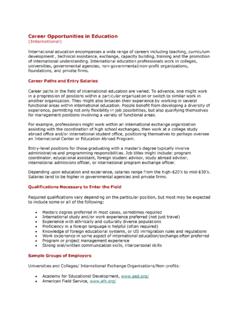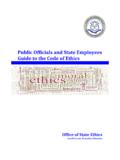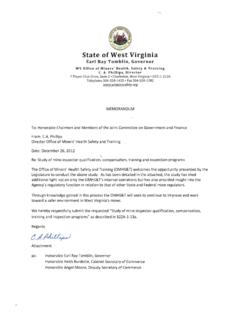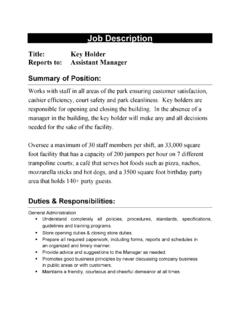Transcription of Groenland Water User Association
1 1 Groenland Water user Association Historical Overview Palmiet River Water plays an important role in our lives and we must ensure that we manage our Water resources in such a manner to ensure the sustainability of these resources. Rivers are an important Water source and are also ecosystems that help maintain our environments natural balance. The catchment area of the Palmiet River is situated in an area which has a Mediterranean-type climate and is characterised by hot dry summers and cold wet winters. The rainfall pattern in the Palmiet basin is orographic in nature (the mountains having an effect on the rainfall). The highest rainfall in the catchment (up to 2 500 mm/annum) occurs on the Hottentots Holland mountains, where the Palmiet River rises in the Landroskop at an altitude of 1 010 m above mean sea level. The Palmiet River basin comprises approximately 500 km2. Flow is generally very seasonal and the catchment area generates a mean annual runoff of approximately 219 million m3.
2 The upper and middle sections of the catchment are farmed extensively (mainly deciduous fruit) and used for plantation forestry. Where it flows through the town of Grabouw and the agricultural areas, the river has been altered quite dramatically from its natural state. In its lower reaches, the Palmiet River flows through the Kogelberg State Forest, now the core of the country s first Biosphere Reserve and which comprises approximately 300 km of the total 500 km catchment area. The result is a river that starts in pristine condition in the mountains, becomes severely degraded in its middle reaches and ends with an acceptable quality of Water due to the inflow of clean Water from its tributaries in the Kogelberg Biosphere Reserve. The mainstream is 74 km long and discharges into the Atlantic Ocean via a small estuary near Kleinmond. The 11 major tributaries to the Palmiet River are listed below, with an indication of the location in relation to the Palmiet River and the length from source to confluence: Keerom River (west; 7,2km); Wesselsgat River (west; 11,2 km); Klipdrif River (west; 9,5 km); Klein Dwars River (west; 2,3 km); Berg River (west; 5,9 km); Klein Palmiet River (west; 8,6 km); Huis River (east; 4,9 km); Kromme River (east; 21,1 km); Dwars River (west; 9,4 km); Louws River (west; 5,8 km); and Oubos River (west; 2,7 km).
3 2 There are 6 instream dams on the mainstream of the Palmiet River, listed with their storage capacity and year of construction: Nuweberg (3,9 million m ; 1971); Eikenhof (29 million m ; 1977); Peninsula (1,1 million m ; 1947); Applethwaite (2,9 million m ; 1952); Kogelberg (19,3 million m ; 1987); and Arieskraal (5,9 million m ; 1967). Groenland Irrigation Board (GIB) Apart from the private dam syndicates and individual riparian owners pumping Water from the Palmiet River, the first two joint projects utilising river Water were known as the Palmiet River Scheme (with 5 members) and the Groenland Winter Water Pumping Scheme (with 18 members). These two separate schemes shared the same hippo pool in the Palmiet River at Elgin Orchards. As fruit farming developed in the valley it became clear that the existing Water resources were inadequate to sustain future development.
4 In 1966 farmers established a Steering Committee under the previous Water Act of 1956, to undertake a major irrigation project which would supply the district with summer irrigation Water . The late Mr. Tim Pare was elected first chairman of this committee and served as chairperson from 9 March 1966 to 18 June 1974. During the time when the late Mr. Leo Fine served as second chairperson (from 18 June 1974 to 9 October 1995), the committee started the process of establishing an Irrigation Board, as well as requested the Department of Water Affairs to build a Government Water Scheme in the Palmiet River. The Minister replied that, due to prior commitments, such a scheme could not be undertaken for at least the next 5 years and advised the committee to build a dam at own expense and then apply for a loan and subsidy for the reticulation scheme, as this could be accommodated in the annual Water Affairs budget.
5 This prompted them to proceed with the appointment of Ninham Shand as consulting engineers and the construction of the Eikenhof Dam, which was completed in 1977. Certain powers regarding the supply of Water to its members were then assigned by the Minister to the Groenland Irrigation Board by virtue of Government Notice No. 991, dated 15 December 1978. Offices and Staff At the inception of the Groenland Irrigation Scheme, the Board rented office space at the Elgin Co-Operative Fruit Growers for many years. During July 1989 the Board bought the property known as portion 55 of the farm Krom River 317 on the Viljoenshoop Road. It was an old building known as the Beaulieu store, and was in a very dilapidated state at the time. Nelia Botha was appointed as architect to design and oversee the large-scale alterations required to the building and site.
6 Building operations were completed by March 1991 and the GIB relocated to the premises at the beginning of April 1991. 3 Although it is now the official offices of the Groenland Water user Association , the property still belongs to the GIB. The following secretaries were employed by the Board on a part time basis: Mrs. E. Aspinall from 1 November 1970 to 30 April 1980; Mrs. V. Swart from 1 May 1980 to 28 February 1982; Mrs. S. Joubert from 1 March 1982 to 30 November 1982; and Mrs. M. Ellmann from 1 November 1982 to 31 August 1999. The following Water Bailiffs were employed by the Board: Mr. G. Scott from 1 June 1975 to 31 August 1995; Mr. W. Wilkinson from 1 January 1979 to 31 March 2006; and Mr. M. van der Merwe from 1 August 1995 to 31 January 2001. In a contractual agreement reached with the Groenland Water user Association in February 2008, the staff complement of the GIB was transferred to the GWUA on 1 March 2008.
7 They are: Danie Bosch - CEO since 1 July 1999; Theo L tter - Bailiff since 1 November 2005; Albert Pontac - Craftsman since 1 October 2006; John Petersen - Labourer since 1 February 1991; and Charles Louw - Labourer since 1 July 1994. The agreement states that the staff will still fulfil the duties required by the GIB, but that this will be done on a time and cost basis. Eikenhof Dam The Eikenhof Dam is located in the upper catchment of the Palmiet River, 2 km from Grabouw, and is situated on the confluence of the Wesselsgat-, Keeroms- and Palmiet Rivers. The catchment that directly feeds the Eikenhof Dam covers about 61 km and generates a virgin mean annual run-off of approximately 45 million m . When completed in 1977, the dam had a total storage capacity of 22 million m3. In 1988 the dam was enlarged to 25 million m3 capacity, at which time the auxiliary spillway was also added.
8 In 1998 the capacity of the dam was once again increased to its present 29 million m3. This was accomplished by demolishing the 1m-high service spillway sill and the 2m-high auxiliary spillway sill and replacing them with a 3m-high reinforced concrete labyrinth on the service spillway and ten reinforced concrete straight-crested Hydroplus vertical fusegates (4,5 m wide and 1,8 m high) on the auxiliary spillway. 4 The service spillway crest level and Full Supply Level of Eikenhof Dam is measured at 317,0 m above mean sea level and covers an area of 270 ha at Full Supply Level. The dam s zoned earthfill embankment is 450 m long and 47 m high. Due to its large size and high hazard, the dam is classified as a Category III dam. The first Safety Inspection Report on the dam was completed in January 1995 and accepted by the Department of Water Affairs and Forestry s (DWAF) Dam Safety Office.
9 During September 1996 DWAF issued a 9B Permit, placing certain conditions on the requested increase in capacity. The Hydroplus Design Report dated August 1998 was therefore completed and accepted by DWAF. The second Dam Safety Inspection Report was completed in October 2003 and accepted by DWAF s Dam Safety Office. The Emergency Plan for Eikenhof Dam is updated annually. Eikenhof Dam is owned, operated and maintained by the Groenland Irrigation Board. At present the scheme supplies irrigation Water to some 6 400 ha of agricultural land on which predominantly deciduous fruit is cultivated, as well as domestic Water to Theewaterskloof municipality (Grabouw village) and local industries such as Appletiser, Two-A-Day, etc. Water Use Entitlements Water use entitlements are based on 6 000 m3 /ha/year for the area. The total yield from the Eikenhof Dam is 38,38 million m3/year, and is registered as follows: Agriculture: 21,71 million m3 (summer allocation) and 10,75 million m3 (winter allocation); Industrial: 0,85 million m3 (summer allocation) and 0,65 million m3 (winter allocation); and Domestic: 2,72 million m3 (summer allocation) and 1,70 million m3 (winter allocation).
10 The Water reticulation system consists of approximately 90 km underground pipes ranging from the nominal 150mm diameter to 900mm dia. Due to the topography of the valley, Water is pumped into several zones and delivered to the boundary of each property. In addition to the above Water use entitlements, the dam releases 0,78 million m3 in summer periods to comply with the ecological flow requirements of the river. Although not a direct Water user in the Groenland Water user Association s area of jurisdiction, the town of Kleinmond (Overstrand Municipality) is allocated 2,25 million m Water per year from the estuary of the Palmiet River. Palmiet Inter-basin Transfer Scheme Phase 1 of the Palmiet Inter-basin Transfer Scheme, which came into operation in September 1998, transfers approximately 27 million m Water per annum from the Palmiet River to the Berg Water Management Area for use by the City of Cape Town when this amount is available for abstraction.





